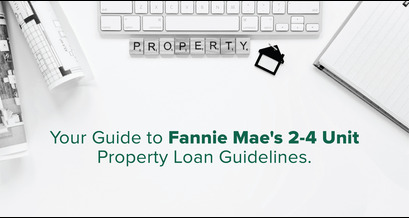Fannie Mae, the Federal National Mortgage Association, provides essential support in the U.S. mortgage market by enhancing liquidity, stability, and affordability. Purchasing 2-4 unit properties is particularly attractive due to the potential rental income and the option to occupy one of the units. Here’s an updated look at Fannie Mae’s guidelines for these properties, including recent changes.
Key Guidelines for 2-4 Unit Properties.
Loan Types and Eligibility.
- Eligible Loan Types: Fannie Mae permits conventional fixed-rate and adjustable-rate mortgages (ARMs) for 2-4 unit properties.
- Occupancy Requirements: These properties can be primary residences, second homes, or investment properties. For primary residences, at least one unit must be owner-occupied.
Loan Limits and Down Payment Requirements.
- Loan Limits: The conforming loan limits for 2-4 unit properties are higher than for single-family homes. In 2023, they were:
- 2-unit property: $1,243,050.
- 3-unit property: $1,502,475.
- 4-unit property: $1,867,275.
- Down Payment: Minimum down payment requirements vary based on occupancy type:
- Primary Residence:
- 2-unit: 15%
- 3-4 unit: 25%
2. Investment Property:
- 2-4 units: 25%
Credit Score Requirements.
- Minimum Credit Scores: Typically, a minimum credit score of 620 for primary residences and 640-680 for investment properties is required.
Debt-to-Income (DTI) Ratio.
- Maximum DTI: The standard maximum DTI is 45%, but can go up to 50% with compensating factors like significant financial reserves.
Reserve Requirements.
- Financial Reserves: Six months of PITI (Principal, Interest, Taxes, and Insurance) is required for both 2-unit and 3-4 unit properties.
Property Condition and Appraisal.
- Appraisal Requirements: Properties must meet Fannie Mae’s safety, soundness, and structural integrity standards.
- Property Condition: Properties must be in good condition, free of major defects, and compliant with local building codes.
Rental Income Considerations.
- Rental Income Use: Borrowers can use rental income from non-owner-occupied units to qualify, with specific documentation requirements.
- Documentation: A lease agreement, rent payment evidence, and a rental income analysis by the appraiser are required.
- Vacancy Factor: Typically, a 25% vacancy factor is applied to gross rental income.
HomeReady® Mortgage.
- HomeReady® Program: Designed for low-to-moderate income borrowers, it offers lower down payment requirements (as low as 3% for primary residences), flexible income guidelines, and reduced mortgage insurance costs. The property must be the borrower’s primary residence.
Recent Developments.
- Increased Loan-to-Value (LTV) Ratio: As of July 2024, Fannie Mae now allows up to 95% LTV for refinancing 2-4 unit properties under certain programs, such as standard and HomeStyle Renovation programs, including HomeReady plans. Previously, the limit was 85%.
- Accessory Dwelling Units (ADUs): Fannie Mae offers financing options for properties with ADUs, which are additional living spaces within a property, compliant with local zoning laws and building codes.
Benefits and Considerations.
Benefits:
- Income Potential: Rental income from 2-4 unit properties can offset mortgage payments and contribute to wealth building.
- Owner Occupancy: Living in one unit while renting the others provides stable income and potential tax benefits.
Considerations:
- Management Responsibilities: Multi-unit properties require commitment to maintenance, tenant relations, and regulatory compliance.
- Financing Complexity: The process can be more complex than single-family homes due to additional underwriting requirements and higher down payments.
Conclusion.
Fannie Mae’s updated guidelines for 2-4 unit properties offer increased flexibility and potential benefits for investors and homeowners. Understanding the specific requirements, including the recent changes to LTV ratios, is crucial for navigating the mortgage process successfully. By adhering to these guidelines, borrowers can leverage the advantages while mitigating risks associated with multi-unit property ownership.
For more detailed and personalized advice, contact our experts at Bond Street Loans. Reach us @(888) 588-5522 or email loaninfo@bondstreetloans.com















